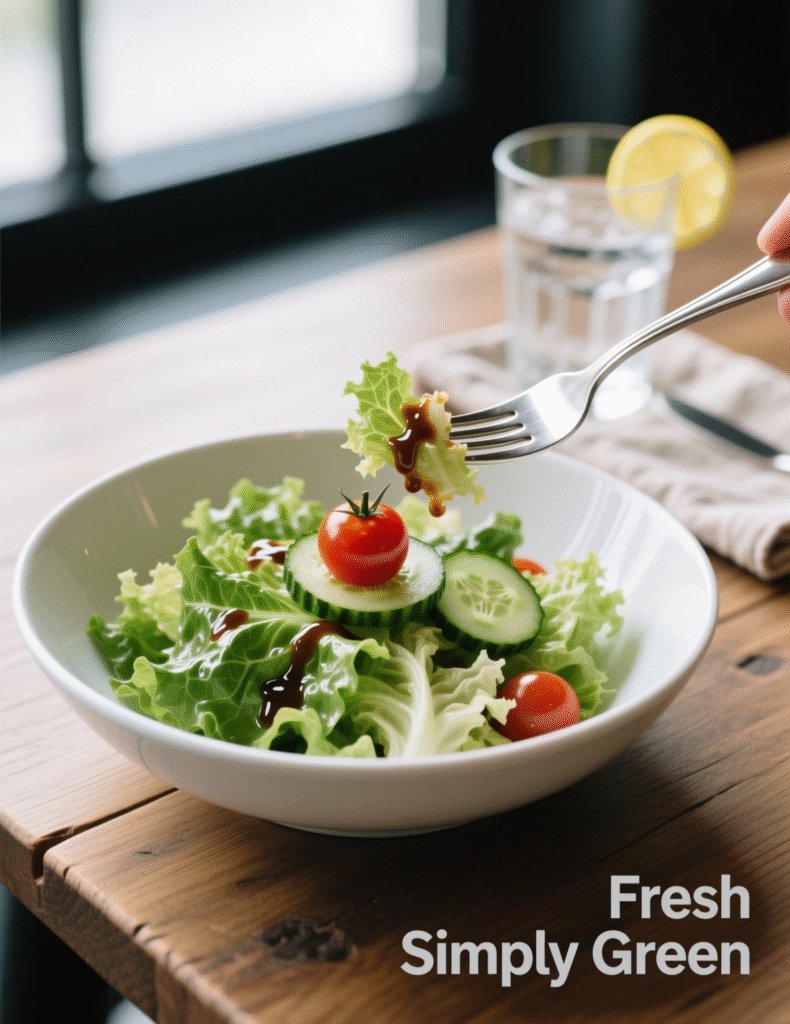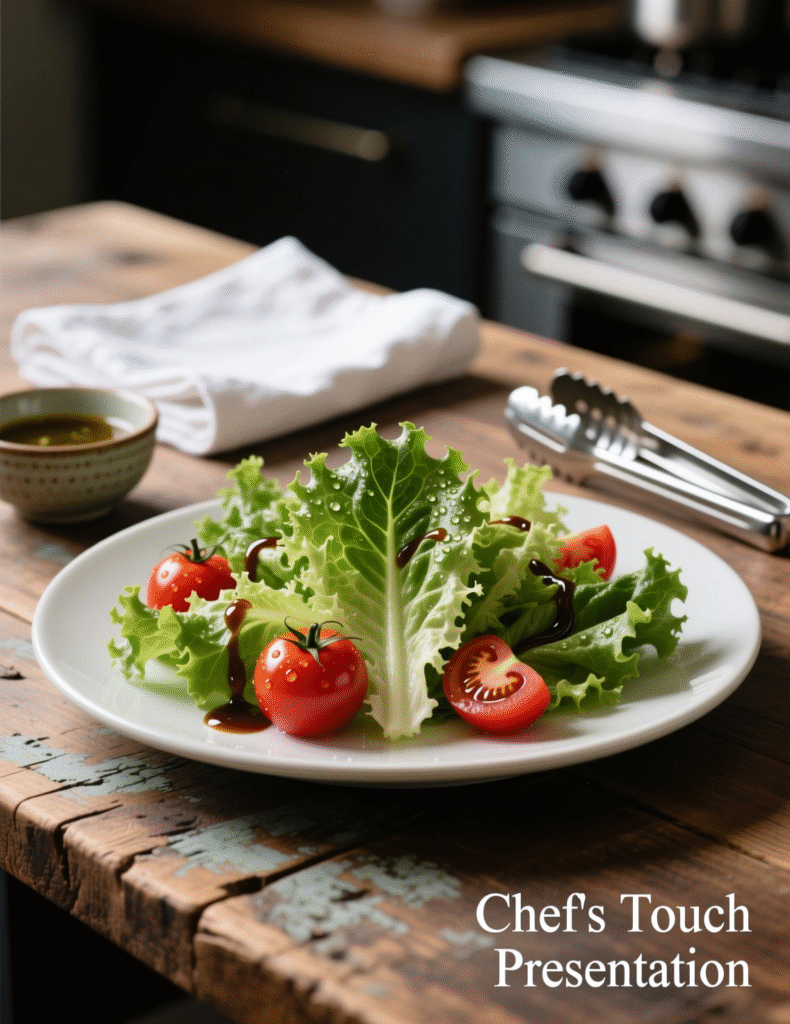Sometimes, the simplest dishes demand the deepest attention. A green salad looks so easy—just toss leaves and drizzle dressing, right? But that’s where most people go wrong. Making a truly fresh, simple green salad that sings with flavor and balance requires an understanding of texture, temperature, and timing. This isn’t about throwing lettuce into a bowl. It’s about building a living, breathing dish that wakes up the palate.
The Philosophy Behind a Perfect Green Salad
Every great chef knows — simplicity hides precision. A salad isn’t just “greens.” It’s a symphony of crisp, bitter, tender, and fragrant notes. The first secret? Freshness. Greens start dying the moment they’re cut, so how you store, wash, and dry them can make or break your salad.
Michel Bras, the French culinary genius, once said the art of salad-making lies in “the respect of each leaf.” That’s not poetic fluff. It’s technique. Handle greens gently. Never over-dress. Let every ingredient breathe.
And please — if your lettuce is soggy, throw it out. Don’t try to “save” it. That’s like putting perfume on spoiled milk.
Ingredients Matter More Than You Think
Here’s the thing — a Fresh Simple Green Salad depends 90% on the quality of its ingredients. There’s no heavy sauce or complex spice blend to hide behind. For 4 servings, you’ll need:
- 4 cups of mixed greens (use butter lettuce, arugula, and baby spinach)
- 1 small cucumber, thinly sliced
- ½ cup fresh herbs (think parsley, dill, or basil — pick one or two, not all)
- 1 small avocado, diced (optional but heavenly)
- ½ cup cherry tomatoes, halved
- ¼ small red onion, sliced paper-thin
- 2 tablespoons extra-virgin olive oil (the best you can find)
- 1 tablespoon freshly squeezed lemon juice
- ½ teaspoon Dijon mustard
- Salt and black pepper, to taste
That’s it. Nothing fancy. Yet every ingredient must be alive with freshness. Greens should snap when you tear them. Tomatoes should smell sweet and earthy. The olive oil — cold-pressed, peppery, and golden.

The Science of Washing and Drying
Most people underestimate this step. Water is your biggest enemy here. Wet leaves repel dressing, leaving your salad flavorless and uneven.
Professionals always wash greens in cold water. That’s not just cleanliness — it’s science. Cold water revives limp leaves by rehydrating plant cells through osmosis. A 2017 study in Food Chemistry showed that soaking vegetables in ice water before serving can increase their crispness by up to 20%.
After washing, use a salad spinner. Don’t have one? Wrap the greens in a clean towel, roll gently, and pat dry. Never crush them. You want them fluffy, not flat.
Balancing Textures and Flavors
A good salad has contrast. You want soft avocado against crunchy cucumber. Peppery arugula beside buttery lettuce. A whisper of acidity to cut through the richness of oil.
Think of your salad like a small orchestra — greens provide the strings, herbs the woodwinds, the dressing the brass. Every bite should hum with balance.
Add-ins like toasted nuts, shaved parmesan, or seeds can elevate your salad from basic to gourmet. But moderation is key. Don’t crowd the greens. The salad should feel light, effortless, alive.
Crafting the Dressing: The Soul of the Salad
Here’s where chefs differ from home cooks. We never buy bottled dressing. Ever. A fresh vinaigrette takes less than a minute and makes all the difference.
For a classic balance, stick to the 3:1 ratio — three parts oil to one part acid. But that’s not a law. Taste it. Adjust it. Some days, the lemon’s sharper; sometimes, the olive oil’s milder. Your tongue tells the truth better than any recipe.
In a small bowl, whisk together the mustard, lemon juice, salt, and pepper. Then slowly drizzle in olive oil while whisking. The mustard helps emulsify the dressing — that’s chemistry in motion, where oil and acid blend instead of separating.
Pro tip: toss your greens with dressing right before serving. Never earlier. Acidity wilts leaves faster than heat does butter.
Layering: The Chef’s Hidden Trick
Don’t just dump everything into a bowl. Build it.
Start with the heartier greens — spinach and lettuce — at the bottom. Then scatter cucumbers and herbs. Add the softer ingredients like avocado and tomatoes last. This prevents bruising and keeps the textures distinct.
When you pour the dressing, use your hands to toss. Not tongs, not spoons. Hands feel what eyes can’t. You’ll know when each leaf is just lightly coated, never drenched.
There’s something intimate about it — mixing salad with your hands connects you to the ingredients. You’re not just cooking; you’re composing.
The Art of Serving
Temperature matters. Always serve your salad slightly chilled, not cold. Too cold, and you mute the flavors. Too warm, and the greens lose their crunch.
For presentation, use wide, shallow bowls. They showcase color and prevent the dressing from pooling at the bottom. Professionals often line a plate with a few extra herbs or microgreens — not for show, but for aroma.
And don’t forget timing. A salad should never sit out too long. Serve immediately after tossing. Even five minutes can dull that crisp, lively texture.
The Nutritional Perspective
A Fresh Simple Green Salad isn’t just pretty. It’s a nutritional powerhouse.
Dark leafy greens like spinach and arugula are packed with vitamins A, C, and K. They’re also rich in antioxidants, especially lutein and beta-carotene, which promote eye health. According to the Journal of Nutrition (2020), a daily serving of mixed greens can lower inflammation markers by nearly 16%.
Add olive oil, and you boost absorption of fat-soluble vitamins. The healthy fats in avocado and oil make those nutrients more bioavailable — meaning your body can actually use them efficiently.
This isn’t diet food. It’s smart food. It feeds your cells, not just your appetite.

Common Mistakes Even Professionals Make
It’s funny — even chefs mess up salad sometimes. The three biggest sins? Overdressing, under-seasoning, and ignoring texture.
A heavy hand with the dressing can drown even the freshest greens. Season your salad like any other dish — salt and pepper matter. A pinch before tossing brightens the whole bowl.
And texture? Non-negotiable. If everything’s soft, you’ve failed. Always add crunch — a cucumber, a nut, even a few crisped chickpeas. The contrast keeps each bite interesting.
Modern Twists and Global Inspirations
The green salad has evolved beyond borders. In Tokyo, chefs add ponzu and sesame seeds for a bright umami edge. In Italy, bitter chicory meets parmesan and balsamic. French chefs use fine herbs and shallot vinaigrette.
One emerging trend — fermented dressings. A light drizzle of kefir or yogurt-based vinaigrette adds probiotics and creaminess without heaviness.
You can also experiment with edible flowers, microgreens, or seasonal fruits. Just remember the golden rule: restraint. A salad should still taste like salad.
A Small Trick: Salt the Greens Before Dressing
Few know this, but a pinch of salt directly on greens before tossing enhances flavor deeply. It draws out subtle bitterness and improves texture. Just don’t overdo it — a whisper of salt, not a shout.
Storage and Prep Tips
If you’re prepping ahead, keep components separate. Wash and dry the greens, then store them in a breathable container with a paper towel to absorb moisture. They’ll stay crisp for 2–3 days.
Dressing? Keep it in a sealed jar. Shake before using. Never store pre-dressed salad — that’s a recipe for sadness.
Professional Insight: Salad as a Skill Test
In fine dining kitchens, making the house salad is often given to the newest line cook — not because it’s easy, but because it reveals everything.
How they handle greens shows respect. How they balance flavors shows instinct. You can tell the future of a cook by how they dress a salad.
A crisp, vibrant salad isn’t a side dish — it’s a statement of craftsmanship.
Example Variation: The Chef’s Personal Touch
Sometimes, I’ll toss in roasted pistachios and a hint of honey in the dressing. That tiny sweetness turns ordinary greens into something luxurious. Other days, I swap lemon for rice vinegar and add toasted sesame oil for a subtle Asian flair.
The point is — once you master the fundamentals, creativity follows naturally. A salad becomes a canvas.
Why Fresh Simple Green Salad Never Goes Out of Style
Trends come and go — molecular gastronomy, foam, fusion. But a well-made green salad? Eternal. It’s food in its purest form — crisp, clean, honest.
It reminds us of why we cook in the first place. To taste nature, unmasked.
Expert Tip: Knife Work Counts
Yes, even your knife technique matters here. Use a sharp chef’s knife to cut cucumbers or onions cleanly. A dull blade bruises vegetables, releasing moisture and dulling color. Always slice, never hack.
Pairing Suggestions
Pair your salad with grilled fish, roast chicken, or even a slice of warm focaccia. The brightness of the greens cuts through richer dishes beautifully.
And if you’re going vegetarian, add a handful of quinoa or lentils to make it heartier. The balance of protein, fiber, and freshness makes for a perfect light meal.
Conclusion: The Simplicity That Demands Mastery
A Fresh Simple Green Salad Recipe for 4 Servings may sound basic, but it’s a test of precision, patience, and understanding. Every detail — from the chill of the greens to the ratio of oil and acid — shapes the outcome.
Respect the ingredients, keep your hands gentle, and trust your palate.
The best salads don’t shout. They whisper freshness, they hum balance, they glow with quiet perfection. And when you nail it, you’ll never look at a bowl of greens the same way again.
FAQs
How many servings does this Fresh Simple Green Salad recipe make?
This recipe makes 4 servings, perfect for a light meal or as a side dish.
What type of greens work best for this salad?
A mix of butter lettuce, arugula, and baby spinach creates the ideal texture and flavor balance.
Can I make the dressing in advance?
Yes, you can prepare the dressing ahead and store it in a sealed jar for up to 3 days.
Should I dry the greens before adding dressing?
Absolutely, dry greens are essential for the dressing to coat evenly and prevent sogginess.
What’s the ideal oil-to-acid ratio for the dressing?
A 3:1 ratio of olive oil to lemon juice gives perfect balance and emulsification.
Can I add proteins to make it a full meal?
Yes, grilled chicken, salmon, or boiled eggs complement the salad beautifully.
How long can I store leftover salad?
Undressed greens can last up to 3 days in the fridge if kept dry and covered.
Is this salad healthy?
Yes, it’s rich in vitamins A, C, K, antioxidants, and healthy fats from olive oil and avocado.
What’s the best way to keep greens fresh?
Store washed and dried greens in a breathable container with a paper towel to absorb moisture.
Can I substitute lemon juice with vinegar?
Yes, white wine or rice vinegar works well if you prefer a milder acidity.
Should I season the salad before or after dressing?
Lightly salt the greens before dressing for better flavor absorption.
How do I prevent the avocado from browning?
Toss avocado in a little lemon juice just before serving to keep it fresh.
Can I use bottled dressing for convenience?
You can, but homemade dressing offers fresher flavor and better ingredient control.
Why is using cold water to wash greens important?
Cold water revives wilted greens and keeps them crisp by tightening plant cells.
What’s the biggest mistake when making a green salad?
Overdressing — it makes greens heavy and soggy instead of crisp and refreshing.

Marie Smith is a passionate recipe blogger, sharing easy, delicious, and creative culinary ideas that inspire home cooks to elevate everyday meals with flavor and simplicity.
